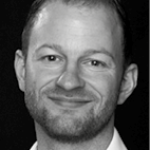Why do we need organizational agility and how does HR fit in?
In Reinventing Organizations, Frederic Laloux briefly examines human evolution. According to him “… for some reason, humanity evolves not continuously, but by sudden leaps” ([Lalo16]). We do not grow gradually, like a tree, but transform “overnight” into something else. He is not the only one who sees the world this way. According to [Pere10] we are currently living during the turning point of one of those leaps, or, as she calls them, “great surges”. Other researchers, academics, organizational architects and management innovators are also recognizing the seismic shift happening in organizations and are calling for change – a change towards more agile, people-centric organizations, operating under agile principles. The timeline in Figure 1 shows a selection of works discussing this organizational change and the new ways of working; it is by no means exhaustive, but merely an illustration of how long visionaries have been urging to embrace the change and prepare for the work of the future.
Figure 1. The case for organizational change embracing agility and its principles, a brief timeline. [Click on the image for a larger image]
What has made this transformation urgent? While not entirely novel, organizational transformation towards agility has been accelerated by a number of factors, such as a multi-generational workforce, digitalization and globalization of organizations, social media, shift to knowledge work, the sharing economy, and most recently, the COVID-19 global pandemic. There is even an acronym to describe some of those economic factors at play – VUCA (volatility, uncertainty, complexity and ambiguity).
What should change? And why is HR best positioned to lead this transformation?
In order to achieve organizational agility, all parts of an organization have to be transformed. We can start by transforming the IT department, for example, but unless the rest of the organization follows, they will soon hit the limits of what they can achieve in isolation. There is one department, however, that spans across departmental boundaries and can affect the entire organization, and that is the HR function. HR owns processes which make the organization what it is, so without HR becoming agile first, an organization cannot truly transform. Once the HR function has embraced agile values and principles and restructured their processes to adopt agile practices, they can start reshaping the organization. Once agile, HR becomes the fertile soil where the seeds of organizational agility can grow further.
What is VUCA and why does it matter?
[Horn10] explain the new nature of the world by four characteristics: volatility, uncertainty, complexity and ambiguity (VUCA).
- Volatility – the speed, volume and the nature of change are different now, than they used to be.
- Uncertainty – the decreased predictability within the market.
- Complexity – the increased chaos around organizations and their issues.
- Ambiguity – the vagueness of reality and the mixed meaning things can have.
These four factors together describe what characterizes the current markets of many businesses. These markets influence the business externally through these changing VUCA characteristics, which results in leaders having to respond to this and change their daily activities and decisions.
VUCA are the characteristics of the new business reality that companies need to deal with. Those characteristics, coupled with the other factors such as multi-generational workforce, digitalization, the shared economy, globalization and knowledge work, have forced a re-evaluation of how companies organize themselves. Organizations are rethinking leadership, culture and structures and how to engage and grow employees, so they, in turn, can serve their customers best.
Multi-generational workforce
A multi-generational workface is characterized by different generations working together. For the first time ever, we are seeing potentially up to five different generations working in the same workplace ([Wind21]). Each of these generations have their own unique personality traits and values ([Wald21]). The differences between these generations are creating an interesting workplace culture and lead to tension if not addressed properly.
Organizational agility needs HR agility to start the transformation and to sustain the new organization
In 2001, a group of software engineers created the Agile Manifesto to change the way they build software. Years later Modern Agile was created in an effort to extend agility outside software development into the organizations themselves. Then, the Agile HR Manifesto addressed agility in workplace culture. While all of these contribute to increased agility, let’s not forget the most important element that has to be transformed – the organization itself! As Edward Deming said almost 30 years ago: “A bad system will beat a good person every time. So fix the system.”
How do we fix the system that is today’s organizations? While “the organization as a machine” dominated the management world for decades, it is no longer relevant in today’s complex reality ([Lalo16]). The organizational processes designed for efficiency and control in the last century cannot serve us well anymore. We have to shift from an enterprise (inherently oriented towards profit) to an organization (inherently oriented towards a goal). A more fitting metaphor today would be “the organization as an organism or social system”. As such, rigid, pre-defined structures and functions are no longer useful and instead organizations should look towards nature for more apt models – schools of fish or flocks of birds, or even a forest’s ecosystem ([Lalo16]). All of these teach us how to quickly respond to change as one complex organism.
It is no longer enough to have a powerful leader with a strong vision that pushes their agenda down the ranks. It is no longer enough to strive for efficiency and control. The only way to deal with a VUCA context is to utilize the power of the collective group and to engage every employee, to coach them (instead of managing them), so they can grow and reach their full potential, in order to best serve their customers. Becoming nimble and regrouping on the go, responding to an ever-changing environment is going to differentiate thriving organizations from those merely surviving.
Organizational change requires participation from the whole organization and cannot be forced top-down. According to [Such11], it takes reflection and discussion to see the patterns of thinking and interaction we are implementing and the new behaviors that might interrupt old patterns or give rise to new ones. To be able to interrupt old patterns, organizations need a new type of leadership to lead this transformation, accompanied by new types of HR processes to enable the culture change required to become an organization of the future. Can we transform HR by applying agile principles and values to create the basis for organizational agility and fix the broken system of today’s organizations? We believe so.
History of agile
The tension that exists between traditional waterfall methods and the rapidly changing complex environments of organizations has led to the adoption of more “lightweight” methodologies ([High01]). A group of researchers came together in 2001 to develop a manifesto that entailed the values and principles of a “lightweight” methodology called agile ([Beck01]). Agile Software Development has allowed organizations to become more responsive and deliver results faster by being able to react more quickly to changes in the business environment ([Meso06]).
The values and principles of the manifesto form the foundation for the several agile methods (e.g. Scrum, KanBan, Lean, XP, DSM, …) that are applied for different reasons and contexts ([Camp15]). While agile and these methods were at first mainly used for software development, there is increased attention for using it in a broader scope ([Rigb16]). According to [Fern09], the contemporary economy is increasingly characterized by uncertain and complex projects for which agile is used to be more adaptable and flexible to face the challenges of these projects.
The concept of business agility and the agile organization itself has recently become popular as people are exploring agility beyond software development and project management alone ([Rigb16]). Often these agile transformations start in IT, the roots of agile software development, but this does not always seem to succeed ([Shei21]). Becoming agile on an organizational level means going through a cultural transformation ([Denn16]).
Agile leadership
Agile leadership is a management style, characterized by prioritizing people over processes, with a focus on customer needs, seeing change as inevitable and value-adding, inspiring and involving employees. It is the management style that can adapt quickly enough to lead an organization operating in a VUCA context and delivering value to customers (who change their mind more often than ever before). Agile leaders are compared to gardeners, instead of the visionaries of the 1980s-1990s, because they nurture and coach their employees, they push decisions closer to the people doing the work and they are aware of their own biases and mind traps, thereby actively avoiding them. To promote motivation, agile leadership is informal and communication flows freely between everyone ([Thor17]). Typically, these leaders embrace the principles of agile (HR), embedding their organization at its core with the ingredients of becoming an agile organization.
How HR becomes agile
Agile HR is a term that has been around for a few years now and can be traced back to the Agile HR Manifesto, signed by 27 professionals in 2017. Like Modern Agile, the Agile HR Manifesto and principles are built on the original Agile Manifesto, reimagined for HR (Figure 2). Also in 2017, Pia-Maria Thoren’s book Agile People, A Radical Approach for HR & Managers describes how to apply agile principles and tools to the world of HR. Since then, a lot has been written on how HR can adopt agile principles and practices to transform the organization from within ([Cappi18]).
Many companies have adopted agile HR practices either from the start of the organization (Buurtzorg, Morning Star) or included HR as part of an agile transformation (ING). When considering traditional HR processes, each one of those processes can or should be reimagined to support the entirety of an agile organization. What these could possibly look like from an agile point of view, is illustrated in Figure 3. Parallel to transforming core HR processes, agility in HR also means a cultural shift for many organizations, with HR owning the transition and reinforcing the agile values and behaviors with the newly reimagined processes, methods and systems.
Figure 2. Agile HR Manifesto and Principles. [Click on the image for a larger image]
Figure 3. HR, reimagined in the agile context. [Click on the image for a larger image]
The organizations of the future are already here
“There is a new generation coming to work that has been deeply shaped by social media, deeply resonant with some of the challenges of the world. Their expectations have been changing faster than the reality of the workplace.”
– Gary Hamel
What do organizations of the future look like? For them to be nimble enough to operate in our reality they need the right type of leadership and the right type of organizational structure. Be it the Humanocracy organizations studied by Gary Hamel and Michele Zanini ([Hame20]), the teal organizations of Frederic Laloux ([Lalo16]), or the organizational trends Corporate Rebels track all over the world, we see a common theme of agility on both leadership and process level that will further support agility of culture and structure. Some common characteristics have been identified, which would form a sound basis and starting point of the necessary mindset and culture (see Figure 4 for comparison between teal organizations and organizational trends from Corporate Rebels). Let’s meet some of them in the box “Organizations of the future that employ Agile HR principles and values”.
Figure 4. Characteristics of Agile organizations according to Frederic Laloux and Corporate Rebels (shown in bold). [Click on the image for a larger image]
Organizations of the future that employ Agile HR principles and values
1 Morning Star
Founded in 1970, the California-based tomato-processing company is an excellent example of a self-organizing company. Morning Star is the worldwide market leader in tomato processing with total revenues close to 1 billion USD annually. It permanently employs 600 employees, with additional 4000 seasonal workers joining the company during harvest season ([deMo17]). Morning Star’s employees determine their own salary increases, which are then reviewed by volunteer peer panels. Furthermore, Morning Star, just like the rest of the organizations presented below, does not have a middle management layer, instead it is comprised of self-steering teams that have no bosses and no job descriptions. The self-management of Morning Star is based on two fundamental principles: all interactions should be voluntary and honor your commitments ([deMo17]).
2 Buurtzorg
Buurtzorg Nederland is a Dutch home-care organization. The word buurtzorg is Dutch for “neighborhood care”. Founded in 2006 by nurse Jos de Blok in response to declining quality and lack of continuity of personal care in the Netherlands and a disillusioned nursing workforce ([CPI18]). Buurtzorg is famous for operating differently than other healthcare providers by having small, self-organizing teams with no leaders and no managers. The purpose of the nurses is not to solely provide health care, such as vaccinations or medication, but to promote patients’ independence as much as possible by working together to discover what they could (learn to) do themselves.
3 ING
With customer behaviors rapidly changing in response to new digital distribution channels, the well-known Dutch bank embarked on their agile transformation in 2015. Agility is now part of their culture, focusing on empowerment, ownership and customer centricity. Every employee spends time at the call center, taking calls from customers when they start working at the bank, and teams are responsible for hiring decisions ([Maha17]). HR had a pioneering role in the transformation – they had the important task of redesigning processes and systems and reinventing their product portfolio, so that they could create the foundation of the new organization and support the new ways of working ([Scho18]).
Some more examples of organizations (non- and for profit) that have changed their management style and support processes are:
- RHD, a human services nonprofit in the United States, 4,000 employees
- Sun Hydraulics, a manufacturing of hydraulic valves and manifolds, global company, 900 employees (for profit)
- Heiligenfeld, network of mental health hospitals in Germany, 600 employees (for profit)
- Morning Star, tomato harvesting, transport and processing in California, United states, 400-2400 employees (for profit)
- Holacracy, an organizational ” operating system” adopted by many organizations throughout the world
- FAVI, brass foundry, automotive supplier, France, 500 employees (for profit)
- Patagonia, outdoor apparel maker and retailer in the United States, 1350 employees (for profit)
- AES, a global producer and distributor of electricity with 40000 employees worldwide in 2001 (for profit)
- ESBZ, a publicly financed grade 7-13 school in Berlin, Germany, with 1500 teachers, students and parents (non-profit)
Source: [Lalo16]
Only when there is a fit between culture and structure, can an organization be truly agile
Agility is the sole answer to operate successfully in a VUCA environment, since organizations of the future need agile leaders and agile processes to support, inspire and help them grow. While some critics have been insisting agile is still a fad, it has slowly permeated every corner of many organizations. We believe agility, both as a mindset and a set of principles to apply, creates a foundation on which organizations can build, motivate and let their workforce be(come) whole. Since HR is the organizational architect, they should be the ones not only redesigning the core processes and structures for agility, but also setting the intention and leading the transformation to adapt and embrace a new mindset. Only when there is a fit between the culture (values and behaviors) and the structure (methods, processes, systems), can an organization be truly agile. And who better to spearhead the cultural and structural change, than HR.
References
[Beck01] Beck, K. et al. (2001). Manifesto for Agile Software Development. Retrieved from: http://agilemanifesto.org
[Camp15] Camponelli, A.S. & Parreiras, F.S. (2015). Agile methods tailoring: A systematic literature review. Journal of Systems and Software, 110(C), 85-100.
[Capp18] Cappelli, P. & Tavis, A. (2018). HR Goes Agile. Harvard Business Review, March-April 2018. Retrieved from: https://hbr.org/2018/03/hr-goes-agile
[CPI18] Centre for Public Impact (2018, November 15). Buurtzorg: revolutionising home care in the Netherlands. Retrieved from: https://www.centreforpublicimpact.org/case-study/buurtzorg-revolutionising-home-care-netherlands
[deMo17] de Morree, P. (2017). Morning Star’s Success Story: No Bosses, No Titles, No Structural Hierarchy. Corporate Rebels. Retrieved from: https://corporate-rebels.com/morning-star/
[Denn16] Denning, S. (2016). How to make the whole organization “Agile”. Strategy & Leadership, 44(4), 10-17.
[Fern09] Fernandez, D.J. & Fernandez, J.D. (2009). Agile Project Management: Agilism versus Traditional Approaches. Journal of Computer Information Systems, 49(2), 10-17.
[Hame20] Hamel, G. & Zanini, M. (2020). Humanocracy: Creating Organizations as Amazing as the People Inside Them. Harvard Business Press.
[High01] Highsmith, J.A. & Cockburn, A. (2001). Agile software development: the business of innovation. Computer, 34(9), 120-127.
[Horn10] Horney, N., Pasmore, B., & O’Shea, T. (2010). Leadership Agility: A Business Imperative for a VUCA World. Human Resource Planning, 33(4), 34-42.
[Lalo16] Laloux, F. (2016). Reinventing Organizations: An Illustrated Invitation to Join the Conversation on Next-Stage Organizations. Nelson Parker.
[Maha17] Mahadevan, D. (2017, January 10). ING’s Agile transformation. McKinsey Quarterly. Retrieved from: https://www.mckinsey.com/industries/financial-services/our-insights/ings-agile-transformation
[Meso06] Meso, P. & Jain, R. (2006). Agile Software Development: Adaptive Systems Principles and Best Practices. Information Systems Management, 23(3), 19-30.
[Pere10] Perez, C. (2010). Technological Revolutions and Techno-Economic Paradigms. Cambridge Journal of Economics, 34(1), 185-202.
[Rigb16] Rigby, D., Sutherland, J., & Takeuchi, H. (2016). Embracing Agile: How to master the process that’s transforming management. Harvard Business Review, May 2016. Retrieved from: https://hbr.org/2016/05/embracing-agile
[Scho18] Schotkamp, T. & Danoesastro, M. (2018, June 1). HR’s Pioneering Role in Agile at ING. Retrieved from: https://www.bcg.com/publications/2018/human-resources-pioneering-role-agile-ing
[Shei21] Sheikh, A. (2021, July 13). Why agile transformations fail in the corporate environment. Forbes. Retrieved from: https://www.forbes.com/sites/forbestechcouncil/2021/07/13/why-agile-transformations-fail-in-the-corporate-environment/?sh=581a584165e3
[Such11] Suchman, A.L. (2011). Organizations as Machines, Organizations as Conversations: Two Core Metaphors and Their Consequences. Medical Care, 49(12), S43-S48.
[Thor17] Thoren, P.M. (2017). Agile People: A Radical Approach for HR & Managers (That Leads to Motivated Employees). Lioncrest Publishing.
[Wald21] Waldman, E. (2021, August 31). How to Manage a Multi-Generational Team. Harvard Business Review. Retrieved from: https://hbr.org/2021/08/how-to-manage-a-multi-generational-team
[Wind21] Windham-Bradstock, C. (2021, December 13). The Value Of Employing A Multigenerational Workforce. Forbes. Retrieved from: https://www.forbes.com/sites/forbeshumanresourcescouncil/2021/12/13/the-value-of-employing-a-multigenerational-workforce/?sh=1289e9b2665f
















